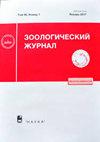PARASITOID COMPLEX (HYMENOPTERA, EULOPHIDAE) OF MINING FLIES (DIPTERA, AGROMYZIDAE) IN THE MIDDLE VOLGA RIVER BASIN
IF 0.3
4区 生物学
Q4 ZOOLOGY
引用次数: 4
Abstract
A parasitoid complex of fifteen Agromyzidae species (Agromyza nana Meigen, Aulagromyza populi (Kalt.), Amauromyza sp. n. aff. insularis, Calycomyza humeralis (von Roser), Chromatomyia horticola (Goureau), Liriomyza eupatoriana Spencer, L. demeijerei Hering, L. dracunculi Hering, L. strigata (Meigen), L. soror Hendel, L. tanaceti de Meijere, L. taraxaci Hering, Ophiomyia quinta Spencer (first recorded for the Palaearctic Region), Phytomyza petoei Hering and Ph. griffithsi Spencer) reared from 20 host plants were studied. A total of 38 host-parasitoid associations were analyzed, 31 of them were previously unrecorded. During this research, 17 Eulophidae parasitoid species (Cirrospilus viticola (Rondani), Chrysocharis pubicornis (Zetter-stedt), Ch. viridis Nees, Ch. crassiscapus (Thomson), Closterocerus tnfasciatus Westwood, Diglyphus crassinervis Erdos, D. chabrias (Walker), D. isaea Walker, D. poppoea Walker, D. pusztensis (Eras, Novicky), Minotetrastichus frontalis (Nees), Neochrysocharis aratus (Walker), N. formosa (Westwood), Pnigalio pectinicornis (Linnaeus), P. soemius (Walker), Pediobius metallicus (Nees) and P. cassidae Erdos)) were found. There are new parasitoid records for the pest species, Ch. horticola, A. nana and Ph. petoei. The number of ectoparasitoid species was 1.25 times greater than that of endoparasitoids in the parasitoid complexes, and the number of reared specimens of ectoparasitoids was 1.7 times greater than that of endoparasitoids. Dominant species of the parasitoid complexes of Agromyzidae were D. isaea (28.4%), Pediobius metallicus (14.5%), N. formosa (13.7%), and Pnigalio soemius (12.7%).伏尔加河中游采蝇(双翅目,粘蝇科)寄生性复合体(膜翅目,粘蝇科)
本文章由计算机程序翻译,如有差异,请以英文原文为准。
求助全文
约1分钟内获得全文
求助全文
来源期刊

Zoologichesky Zhurnal
生物-动物学
CiteScore
0.80
自引率
33.30%
发文量
17
审稿时长
3-8 weeks
期刊介绍:
Information not localized
 求助内容:
求助内容: 应助结果提醒方式:
应助结果提醒方式:


